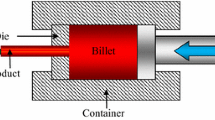Abstract
The objective of this study is to present a new numerical strategy using soft-computing techniques to determine the optimal die gap programming of extrusion blow molding processes. In this study, the design objective is to target a uniform part thickness after parison inflation by manipulating the parison die gap openings over time. To model the whole process, that is, the parison extrusion, the mould clamping and the parison inflation, commercial finite element software (BlowSim) from the National Research Council (NRC) of Canada is used. However, the use of such software is time-consuming and one important issue in a design environment is to minimize the number of simulations to get the optimal operating conditions. To do so, we proposed a new strategy called fuzzy neural–Taguchi network with genetic algorithm (FUNTGA) that establishes a back propagation network using a Taguchi’s experimental array to predict the relationship between design variables and responses. Genetic algorithm (GA) is then applied to search for the optimum design of die gap parison programming. As the number of training samples is greatly reduced due to the use of orthogonal arrays, the prediction accuracy of the neural network model is closely related to the distance between sampling points and the evolved designs. The extrapolation distance concept is proposed and introduced to GA using fuzzy rules to modify the fitness function and thus improving search efficiency. The comparison of the results with commercial optimization software from NRC demonstrates the effectiveness of the proposed approach.
Similar content being viewed by others
References
BlowSim, 6.0 (1999) Industrial Materials Institute, National Research Council Canada.
Diraddo, R. W. and Garcia-Rejon, A. (1993a) On-line prediction of final part dimensions in blow molding: a neural network computing approach. Polymer Engineering and Science, 33(11), 653–664.
Diraddo, R. W. and Garcia-Rejon, A. (1993b) Profile optimization for the prediction of initial parison dimensions from final blow moulded part specifications. Computers Chem. Engineering, 17(8), 751–764.
Jang, J. S., Sun, C. T. and Mizutani, E. (1997) Neuro-Fuzzy and Soft Computing: A Computational Approach to Learning and Machine Intelligence, Prentice-Hall.
Laroche, D., DiRaddo, R. W. and Aubert, R. (1996) Process modeling of complex blow-molded parts. Plastics Engineering, 52(12), 237–239.
Laroche, D., Kabanemi, K., Pecora, L. and DiRaddo, R. W. (1999) Integrated numerical modeling of the blow molding process. Polymer Engineering and Science, 39(7), 1223–1233.
Lee, D. K. and Soh, S. K. (1996) Prediction of optimal preform thickness distribution in blow molding. Polymer Engineering and Science, 36(11).
Rosato, D. V. (ed.) (1989) Blow Molding Handbook, Hanser Publisher, Munich.
Su, C. T., Chiu, C. C. and Chang, H. H. (2000) Parameter design optimization via neural network and genetic algorithm. International Journal of Industrial Engineering, 7(3), 224–231.
Taguchi, G. (1978) Performance analysis design. International Journal of Production Research, 16, 521–530.
Author information
Authors and Affiliations
Rights and permissions
About this article
Cite this article
Yu, JC., Chen, XX., Hung, TR. et al. Optimization of extrusion blow molding processes using soft computing and Taguchi’s method. Journal of Intelligent Manufacturing 15, 625–634 (2004). https://doi.org/10.1023/B:JIMS.0000037712.33636.41
Issue Date:
DOI: https://doi.org/10.1023/B:JIMS.0000037712.33636.41



